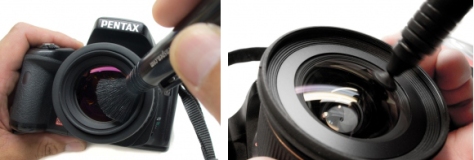Here is my list of products that I use for cleaning my camera and lenses with a brief description of its use to give you some idea. Click on the product name for link to site for purchase, also read the reviews on those sites for tips and more insights from other users.
Giottos Rocket Air Blower
 I always have this handy and use it the most, this blower packs a quite a strong blast of air and I use it on every nook and cranny of my DSLR, lenses and other gear. I even use it on my keyboard and computers… as I consider these part of my gear too.
I always have this handy and use it the most, this blower packs a quite a strong blast of air and I use it on every nook and cranny of my DSLR, lenses and other gear. I even use it on my keyboard and computers… as I consider these part of my gear too.
LensPen
 I use the brush end of the LensPen the most and their carbon compound tip for the lens glass surface although I mainly use the Pec Pads the most on the lens glass.
I use the brush end of the LensPen the most and their carbon compound tip for the lens glass surface although I mainly use the Pec Pads the most on the lens glass.
Pec Pads and Eclipse Optical Cleaning Fluid
 The lint free Pec Pads coupled with the Eclipse Optical cleaning fluid are just awesome for cleaning your lenses and other parts of the camera such as the metal lens ring on the camera body and lens and other glass such as the viewfinder and filters.
The lint free Pec Pads coupled with the Eclipse Optical cleaning fluid are just awesome for cleaning your lenses and other parts of the camera such as the metal lens ring on the camera body and lens and other glass such as the viewfinder and filters.
Opteka Pre-Moistened CCD/CMOS Sensor Cleaning Swabs
 I use the Opteka sensor cleaning swabs when I start seeing dust spots on my images. From their product description these sensor swabs are pre-moistened with a Tin Oxide cleaning solution, which leaves no visible residue and is specifically designed for CCD/CMOS chips.
I use the Opteka sensor cleaning swabs when I start seeing dust spots on my images. From their product description these sensor swabs are pre-moistened with a Tin Oxide cleaning solution, which leaves no visible residue and is specifically designed for CCD/CMOS chips.
Now I know that cleaning the sensor is a “sensitive” subject for some, and a lot of people would prefer to have this done through a service performed at your local camera shop. That is totally understandable if you do not feel comfortable doing this yourself. Read on to get an idea of how its done at home.
The swabs each come double sealed, be sure you are ready to use swab right away when you open package (so it does not dry out too much before use). I first blow out and brush off the sensor area then per instructions on package – with firm pressure, wipe horizontally across sensor in one motion and without lifting the swab off the sensor wipe across in the opposite direction. Allow up to 5 minutes before turning on camera. Done!
Conclusion.
It was great sharing this with everyone and I hope you found some of these products useful to you. What products do you use? Questions? Feel free to comment below!


Great post. Thanks
Thanks Jay 🙂
Robert, nice post, I always have my cameras upside down with blowing or brushing so debris will fall out vs falling back in. I also try to keep my cameras inverted when changing lenses, same principle, less likely for dirt to settle into the open camera if it is upside down. Swapping is different as it does not make particle airborne. Just a thought.
Cool, thanks for the input Bryan!
One thing I recommend for cleaning lenses is avoiding all of the standard professional cleaners and just using Ronsonol or Coleman Camp Fuel. I know it may sound counter-intuitive or bizarre, but these are both pure naphtha – which is an extremely light grade non-polar petroleum distillate. Almost all pro cleaners use some combination of it or isopropanol. It’s ideal because its safe for all metal and glass (and most non-polystyrene plastics) and will remove all grime, fingerprints, or oil-based deposits easily while at the same time evaporates faster than isopropanol and with no residue at all (it completely evaporates and contains no water).
I’ve cleaned many many lenses with just straight Coleman camp fuel and pec pads and there has never been any kind of issue – even with older coatings. This is not surprising as it’s a non polar solvent and cannot harm metallic or glass surfaces (nor painted ones).
What the manufacturers don’t tell you is that almost all lens servicing and professional cleaning houses use straight ether or naphtha. The cost difference is ridiculously advantageous for not using a commercially packaged cleaner like Eclipse or others and just sticking with raw chemicals.